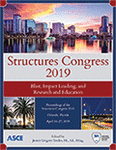Structures Congress 2019
Effectiveness of Progressive Collapse Resistance Criteria against Blast Loading
Publication: Structures Congress 2019: Blast, Impact Loading, and Research and Education
ABSTRACT
Current design standards provide methodologies to analyze and design structures against disproportionate collapse, colloquially referred to in instances as progressive collapse. While these standards generally improve the overall robustness of structures, it is not known with a high degree of certainty how these structures will perform directly against blast loading. There is a need for blast and structural engineers alike to incorporate disproportionate collapse mitigations that adequately address specific design basis threats (DBT), such as blast. This paper tests the tie-force collapse prevention methodology outlined in UFC 4-023-03 (2013), against a vehicle borne improvised explosive device (VBIED) detonated within an internal basement. Consideration is given to a typical multi-story structural steel building frame where the tie force method has been applied. Empirical methods are used to determine the applied blast loading and finite element analysis (FEA) is used to analyze the highly transient structural response under these loads. Expected levels of damage and the limitations of using a standardized approach to collapse prevention are summarized within this paper. The purpose of this paper is to provide blast engineering practitioners an understanding of considerations in applying general collapse prevention provisions in lieu of an assessment where a blast DBT is modeled explicitly.
Get full access to this article
View all available purchase options and get full access to this chapter.
REFERENCES
Arup (2011). “Review of international research on structural robustness and disproportionate collapse.” Department of Communities and Local Government and Centre for Protection of National Infrastructure CPNI, UK. Crown copyright.
Ding, Y. et al. (2016). “Progressive collapse analysis of a steel frame subjected to confined explosion and post-explosion fire.” Advances in Structural Engineering, Vol. 19 (11), pages 1780-1796.
Field, C.J. et al. (2012). “Steel Moment Frame Connection Performance Limits for Disproportionate Collapse,” American Society of Civil Engineers (ASCE) 20thAnalysis & Computation Specialty Conference, pages 449-463.
Gombeda, M.J. et al. (2016). “Blast-Induced Damage Mapping Framework for Use in Threat-Dependent Progressive Collapse Assessment of Building Frames,” American Society of Civil Engineers (ASCE) Journal of Performance of Constructed Facilities, Vol. 31 (2), pages 04016089-1–04016089-16.
GSA (General Services Administration). (2013) Alternate Path Analysis & Design Guidelines for Progressive Collapse Resistance. General Services Administration.
Jeyarajan, S. et al. (2015). “Analysis of Steel-Concrete Composite Buildings for Blast Induced Progressive Collapse,” International Journal of Protective Structures, Vol. 6 (3), pages 457-485.
Sideri, J. et al. (2017). “Distributed Column Damage Effect on Progressive Collapse Vulnerability in Steel Buildings Exposed to an External Blast Event,” ASCE.
UFC (Unified Facilities Criteria). (2013) Design of Buildings to Resist Progressive Collapse, UFC 4-203-03. Department of Defense, Washington, DC.
VA (U.S. Department of Veterans Affairs). (2015) Physical Security Design Manual for VA Life-Safety Protected Facilities, VA.
VA (U.S. Department of Veterans Affairs). (2015) Physical Security Design Manual for VA Mission Critical Protected Facilities, VA.
Wilson, D. et al. (2018). “Implementation of MCEER TR 14-0006 Blast Load Curves in LS-DYNA and Benchmark to Commonly Practiced Blast Loading Application Methods,” 15th International LS-DYNA Users Conference.
Information & Authors
Information
Published In
Structures Congress 2019: Blast, Impact Loading, and Research and Education
Pages: 158 - 171
Editor: James Gregory Soules, McDermott International
ISBN (Online): 978-0-7844-8224-7
Copyright
© 2019 American Society of Civil Engineers.
History
Published online: Apr 22, 2019
Published in print: Apr 22, 2019
Authors
Metrics & Citations
Metrics
Citations
Download citation
If you have the appropriate software installed, you can download article citation data to the citation manager of your choice. Simply select your manager software from the list below and click Download.
